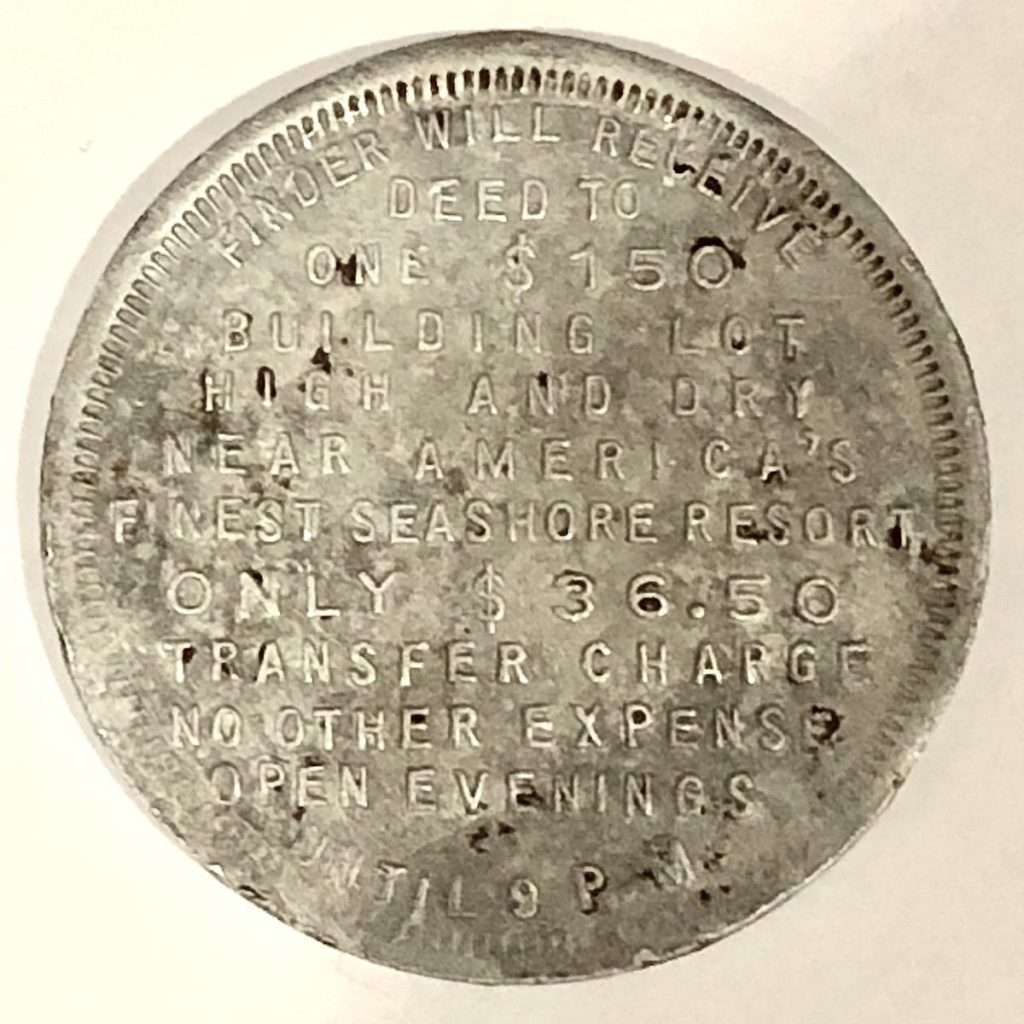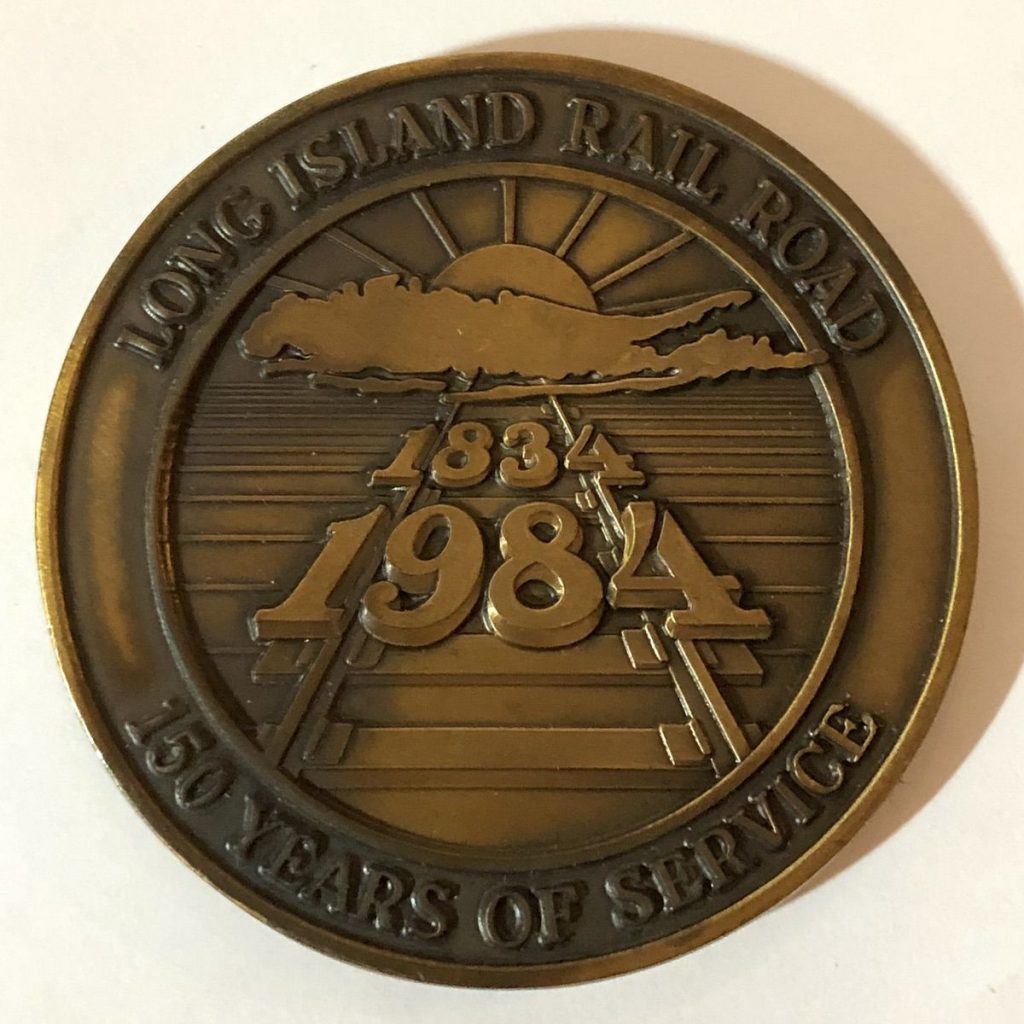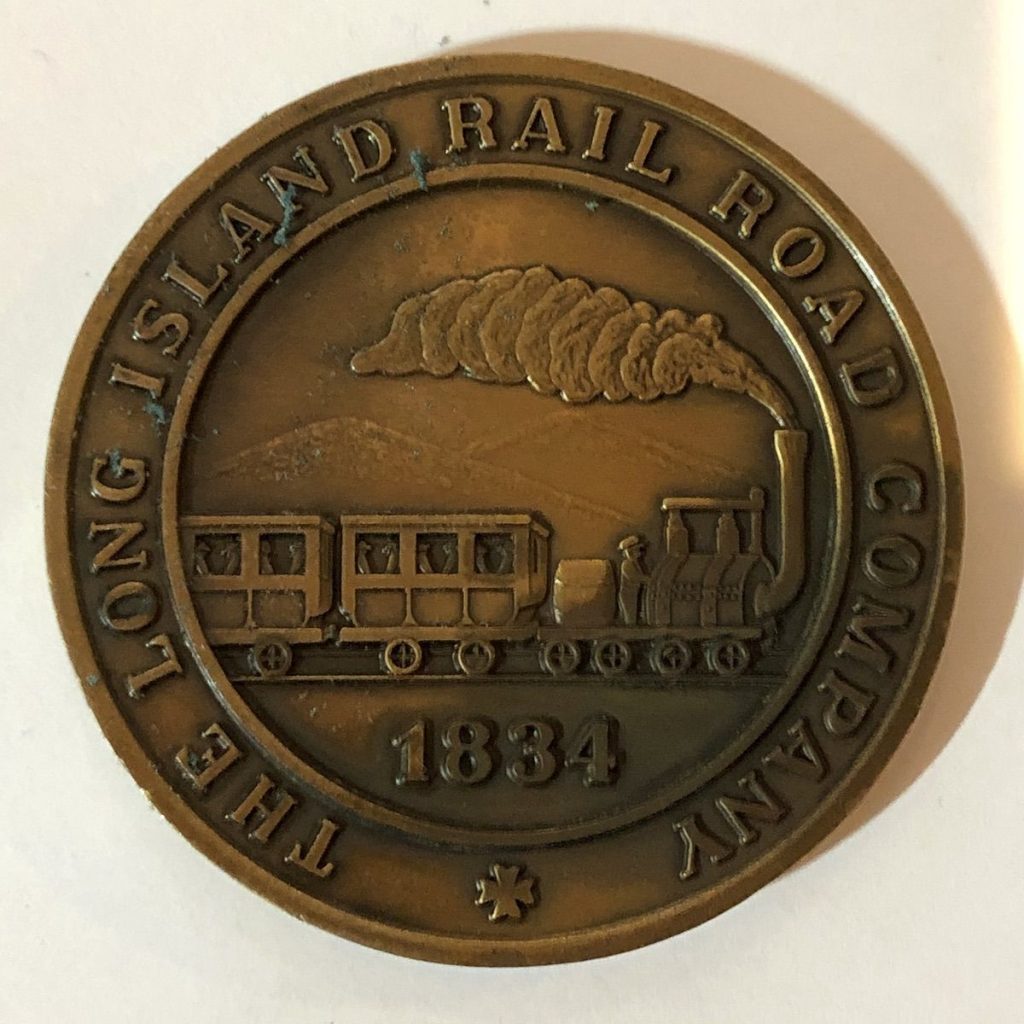Feb 28, 2022 | coins, history, news, quarter
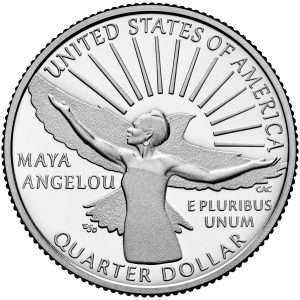
2022 Maya Angelou Quarter
Another numismatic celebration came with the first American Women Quarters Program featuring writer, poet, performer, social activist, and teacher Maya Angelou.
These are two events that the numismatic community can use to demonstrate diversity and attract more collectors. With the national attention on the new quarters and Gibson’s appointment, it is an opportunity not seen since the 50 State Quarters Program over 20 years ago.
WRC, the NBC owned and operated station in Washington, DC, interviewed Ventris Gibson as part of their Black History Month series. Here is the interview they aired:
And now the news…

February 21, 2022
Juneteenth Commemorative Coin 2021 by Juneteenth Unlmited Black owned Small Business Releases Historic Commemorative Coin for Juneteenth 2021

→ Read more at
einnews.com

February 24, 2022
A Kirkcaldy man tried to pass off thousands of pounds worth of fake £2 coins as genuine at post offices across Fife in the hope of changing them into legitimate cash.

→ Read more at
thecourier.co.uk

February 25, 2022
As the financial year of the temple treasury began on Rosh Chodesh Nisan from which date certain requirements of the sacrificial service could only be purchased with funds from that year, those proclamations were made to give a month’s notice to people to pay these annual dues required to be deposited in the temple Treasury.

→ Read more at
australianjewishnews.com
Dec 15, 2021 | history, tokens
As I have been searching for hometown numismatics, I have been coming across merchant tokens that advertises deed to land for what seems to be a low price. All of the tokens have a Manhattan address, and all say that the business is open until 9 P.M.
None of the tokens have dates, but all have the same address. One side of the token describes what is being offered:
Finder will Receive / Deed to / One $150 / Building Lot / High and Dry / Near America’s / Finest Seashore Resort / Only $36.50/ Transfer Charge. / No Other Expenses / Open Evenings / Until 9 P.M.
The reverse says that the token has to be returned within 96 hours to the Advertising Department, Room 1274, in the Longacre Building at the corner of 42nd Street and Broadway.
According to public data available online, the Longacre Building was a 12-floor building in Times Square that opened in 1912. Before 1904, Times Square was known as Longacre Square, and the area was renamed when the New York Times opened its headquarters on the property of the old Pabst Hotel.
Some websites documenting old New York City buildings identify the same address as the Longacre Hotel from 1917 through 1932. It is possible that the building was turned into an inexpensive hotel, and the advertiser rented a room at the hotel.
Documentation suggests that the city demolished the building during the Great Depression using New Deal funding.
As I was looking for answers, a friend that is a professor in one of the city’s many colleges speculates that a Florida government issued the token. Early in the 20th century, Florida governments came to New York to entice New Yorkers to move to areas north of Miami or purchase land for second homes.
The condition of the sale or deed transfers is not known.
Many of New York City’s historical records are held at the main New York Public Library, not far from the Longacre Building once stood. Some day, I will go to the library to research the old records to find the story behind these tokens. Maybe it is an excellent excuse to go home in time for NYINC.
Mar 9, 2021 | gold, history
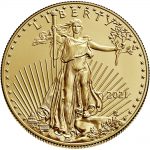 Sometimes, finding a link to a page that describes what things were like the year you were born can lead to educational and fun reading.
Sometimes, finding a link to a page that describes what things were like the year you were born can lead to educational and fun reading.
A friend sent a link to an October 2020 article on Stacker titled “Cost of gold the year you were born.” Aside from finding out that gold broke the $35 barrier the year I was born, the article outlines economic history from 1920 to 2020.
Some of the descriptions also will help explain some of the numismatic decisions that affect collectors. Understanding the economic history behind money can help understand where collectibles are today.
While reading through the list, I picked out ten significant highlights of the last 100 years:
- 1932: The last year the U.S. Mint struck gold coins that were circulated
- 1949: Switzerland stops minting the 20 Franc gold coin, the last gold coin struck for circulation
- 1955: San Francisco Mint stopped coining operations (it would return 13 years later)
- 1967: South Africa introduces the Krugerrand
- 1975: Gold ownership made legal again
- 1979: Canada introduces the gold Maple Leaf
- 1982: China introduces the gold Panda
- 1985: Reagan signs the Gold Bullion Coin Act
- 1998: The euro is introduced
- 2000: The Denver Mint produced 15.4 billion coins, the most of any mint
Understanding history is another way to get more out of your collection.
Read! Educate! And collect!
Sep 10, 2020 | history, medals
My desk is nowhere near being clean and organized as I would like it to be. Tonight, I lifted a stack of papers looking for something and found my Long Island Railroad Sequicentenial bronze medal.
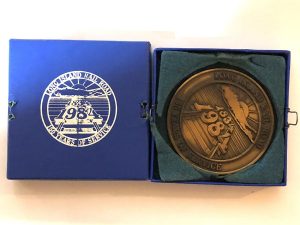 The Long Island Railroad (LIRR) is the largest commuter railroad in the United States. The LIRR runs the length of Long Island to bring commuters into New York City in the morning and home in the afternoon. The LIRR is part of everyone’s life in Nassau or Suffolk Counties, even if you are not a commuter.
The Long Island Railroad (LIRR) is the largest commuter railroad in the United States. The LIRR runs the length of Long Island to bring commuters into New York City in the morning and home in the afternoon. The LIRR is part of everyone’s life in Nassau or Suffolk Counties, even if you are not a commuter.
When the LIRR was chartered on April 24, 1834, its mission was to provide rail service between New York City and Boston. The service used a ferry connection between Greenport on Long Island’s North Fork and Stonington, Connecticut. Weather and other issues forced that route to stop operating in 1849, but overland routes continued.
The Pennsylvania Railroad purchased the Long Island Railroad in 1900. They broke up the service that went north to Boston and the Long Island segments. The northern service is now part of Metro-North, the third-largest commuter railroad. The LIRR remained as a service to Long Island for both commuter and freight rail.
After World War II, the new middle class began to purchase more cars, causing a decline in ridership. In the early 1950s, New York State began to subsidize commuter rail services around New York City. By 1965, the state purchased the LIRR from the Pennsylvania Railroad to create the Metropolitan Commuter Transportation Authority (MCTA). A short time later, the state bought Metro-North from the New York Central Railroad, who previously purchased it from the Pennsylvania Railroad. When the state completed the purchase of the three remaining subway lines, the agency was renamed the Metropolitan Transportation Authority (MTA).
Today, the MTA is responsible for the New York City Transit Authority (subway and busses), the bridges and tunnels in New York City, the LIRR, Metro-North, and a cross-jurisdiction police department run under state authority. The MTA partners with New Jersey Transit for the parts of their service that run in New York. New Jersey Transit is the second-largest commuter rail service.
Remarkably few railroads have survived in the United States, but the LIRR is still going. The LIRR is the oldest commuter rail service in the United States. It was quite an accomplishment to celebrate 150 years. Along with the announcements of service improvements, the LIRR created many souvenirs, including a bronze medal.
The Medallic Arts Company designed and struck a 64mm (2.5 inches) 5mm thick bronze medal for the LIRR. The obverse depicts the logo the LIRR used to celebrate the sesquicentennial. The reverse uses a logo found on stock certificates from the mid 19th century. It may not have been the original logo, but it was the oldest found.
The surface of the medal has an antiqued finished and appears to have a shellac coating.
Senior executives received the medals as a bonus, and many were given to VIPs. Employees could purchase medals from the LIRR Public Affairs office in Jamaica Station for $8 per medal. To purchase the medals, employees had to provide their “IBM Numbers” at the purchase time.
For those not old enough to remember, “IBM Numbers” were early employee identification numbers. The name came from the number a computer, the company’s IBM mainframe, and assigned to the employee. Companies that used the system would use a punchcard system to identify employees.
The medal is not common but not scarce. Several years ago, an inquiry to the LIRR about the medals amused their public relations department. Aside from not having records that old, nobody in the office worked for the LIRR when the medals were issued.
A casual study of the market shows that most are missing the presentation box. The presentation box was likely only available to the executives and VIPs. It is more difficult to find the medal with the original presentation box.
If you like what you read, share, and show your support 
Jul 21, 2020 | history, tokens
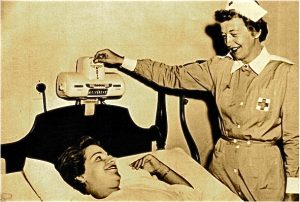
The Dahlberg Radio in a hospital setting
Newspapers were the dominant media of the day. Many broadsheets published two or three times a day plus special editions. The provided news, stories, and advertising, but there was always a delay. Broadcast radio began to change how news was delivered, starting with the first commercial radio stations in the early 1920s. Although the first radio stations experimented with the new format, by the late 1920s, radio offered a wide range of programming.
Like all new technology, radios were expensive. Manufacturing processes would take a while to lower costs. But as radio began to become popular, the Great Depression slowed its growth.

Ken Dahlberg
Dahlberg sold tokens to the hospital with their name on it in an attempt from people taking the tokens to other hospitals. The tokens were the size of a dime with a hole in the center. It was a pay-per-listen radio when the medium was popular. By the mid-1950s, technology reduced the size of the radio, and the family of patients brought their radios.
-

-
The common obverse of the Dahlberg Radio Token
-

-
Reverse of a Dahlberg Radio Token from Franklin Hospital in Franklin, PA
Dahlberg stopped making radios in the early 1960s to pursue other ventures. The hearing aid company Miracle-Ear was a subsidiary of Dahlberg electronics.
In 1972, Ken Dahlberg was the midwest finance chair for the Committee to Re-Elect the President. Dahlberg facilitated the payments that eventually found its way into the bank account of one of the Watergate burglars. He was never charged with a crime since it was clear he was following the campaign finance procedures and did not have knowledge of where the money was going.
Dahlberg radio tokens are scarce but not difficult to find. People who collect these tokens look for different hospitals, and different cities struck in the metal. One collector said that he had found tokens from 21 different hospitals in 20 different cities. Collectors do not know the number of hospitals that had tokens made, and there has been no attempt to document the ones found.
The tokens pictured above were found mixed with other collectible items. Their discovery allowed for a look back to an interesting past.
If you like what you read, share, and show your support 
Aug 1, 2019 | Carson City, coins, commemorative, history, legislative, US Mint
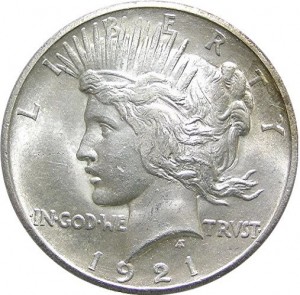
1921-D Peace Dollar
The bill calls for the issue of no more than 500,000 $1 silver coins commemorating the Morgan dollar and the Peace dollar in 2021. If passed, 2021 will mark the 100th anniversary of the end of the Morgan Dollar and the beginning of the Peace Dollar.
Aside from being excited about the issue of the coin, the one line that has caught the interest of collectors is that “it is the sense of Congress that if the Secretary determines it to be feasible and cost effective, the Secretary may mint some of the coins minted under this Act at the Nevada State Museum (formerly a United States Mint facility) located in Carson City, Nevada.”
Although it seems like a good idea, there are a lot of questions whether striking coins in Carson City would be feasible. Since the facility is an active museum, would Nevada be willing to give up a piece of their operations to the federal government? How disruptive would be to the museum’s activities before and after striking the coins?
How would the U.S. Mint strike coins at the museum? While the facility has old coining presses used for demonstrations, they may not be capable of manufacturing modern coinage. Then there is the other equipment involved including an upsetting mill to put an edge on the coin.
The Carson City Mint was built in 1863 to building codes and security standards of the mid-19th century. After the Mint stopped striking circulating coins in 1893, the building became as Assay Office. In 1933, the Great Depression ended its service as an Assay Office. The federal government sold the building to Nevada in 1939. While the Nevada State Museum has updated the building’s security, it is doubtful that it would meet modern U.S. Mint requirements.
Striking coins with the CC mintmark may have an appeal to the collecting community, it might not be feasible and cost-effective.
S. 239: Christa McAuliffe Commemorative Coin Act of 2019
Summary: (Sec. 3) This bill directs the Department of the Treasury to mint and issue not more than 350,000 $1 silver coins in commemoration of Christa McAuliffe, a teacher tragically killed in the Space Shuttle Challenger Disaster.(Sec. 4) The design of the coins shall bear an image and the name of Christa McAuliffe on the obverse side and a design on the reverse side that depicts the legacy of McAuliffe as a teacher.(Sec. 5) Treasury may issue the coins from January 1-December 31, 2021.(Sec. 7) All surcharges received by Treasury from the sale of the coins shall be paid to the FIRST robotics program for the purpose of engaging and inspiring young people, through mentor-based programs, to become leaders in the fields of science, technology, engineering, and mathematics.
Held at the desk. — Jul 10, 2019
Received in the House. — Jul 10, 2019
Message on Senate action sent to the House. — Jul 10, 2019
Passed Senate with amendments by Voice Vote. — Jul 9, 2019
Measure laid before Senate by unanimous consent. — Jul 9, 2019
Senate Committee on Banking, Housing, and Urban Affairs discharged by Unanimous Consent. — Jul 9, 2019
Read twice and referred to the Committee on Banking, Housing, and Urban Affairs. — Jan 28, 2019
The Senate passed the Christa McAuliffe Commemorative Coin Act of 2019 in July. Like the Women’s Suffrage Centennial Commemorative Coin Act (S. 1235) passed in June, the bill is being held at the desk in the House of Representative because of an objection by one of its members.
A source claims that a freshman member of the House has objected to these bills being first passed by the Senate. This member cites Article I Section 7 of the United States Constitution where it says that “All bills for raising revenue shall originate in the House of Representatives.” A spokesperson in the House ’Clerk’s office would not confirm or deny the ’source’s claim.
H.R. 3757: 1921 Silver Dollar Commemorative Coin Act
Referred to the House Committee on Financial Services. — Jul 15, 2019
Jul 16, 2019 | celebration, coins, commemorative, history
“We choose to go to the moon. We choose to go to the moon in this decade and do the other things, not because they are easy, but because they are hard, because that goal will serve to organize and measure the best of our energies and skills, because that challenge is one that we are willing to accept, one we are unwilling to postpone, and one which we intend to win, and the others, too.”
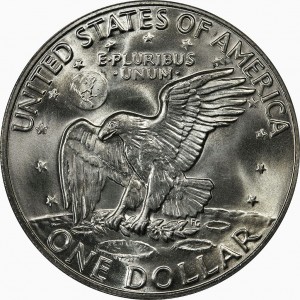
Eisenhower Dollar Reverse featuring the Apollo 11 mission insignia
Kennedy’s vision was accomplished by the Apollo 11 crew of Commander Neil Armstrong, Command Module Pilot Michael Collins, and Lunar Module Pilot Edwin “Buzz” Aldrin along with the thousands of support people on Earth. A little more than eight years after Kennedy made it the nation’s policy, Apollo 11 launched from Cape Kennedy on July 16, 1969.
From within the capsule attached to the top of the Saturn V launch vehicle, a rocket once described as a giant Roman candle, the rocket roared to life to lift the three pioneers into the final frontier. Even though the liftoff occurred at 9:32 AM in Florida, it was watched worldwide regardless of the local time.
Four days later, on Sunday, July 20, 1969, the world held its collective breath as the Lunar Module (LM), call-sign Eagle, was guided to the moon’s Sea of Tranquility and landed at 4:18 PM Central Time. Relief came when Neil Armstrong transmitted a message to Mission Control in Houston:
“Houston, Tranquility Base here. The Eagle has landed.”
CAPCOM (Capsule Communicator) Charles Duke’s response summed up the feel of those of us on Earth as he stumbled a bit at the beginning:
“Roger, Twan– Tranquility, we copy you on the ground. You got a bunch of guys about to turn blue. We’re breathing again. Thanks a lot.”
According to the official schedule, Armstrong and Aldrin were supposed to get five hours of sleep. Realizing that it was unlikely they would be able to sleep, the crew prepared for the first walk on the moon’s surface.
Six and a half hours after landing, after Walter Cronkite and the CBS News team showed models as to how Armstrong will descend from the LM, pull the D-Ring to activate the camera, Armstrong left the LM and went down the latter. He pulled the D-Ring, and the world watched his progress. Just before reaching the surface of the moon, Armstrong uncovered a plaque mounted on the LM that read:
Armstrong looked at the surface and described the moon’s dust as “very fine-grained” and “almost like a powder.” Then with a short jump, he left the bottom rung of the ladder and was standing on the surface of the moon.
“That’s one small step for [a] man, one giant leap for mankind.”
Over the years, there has been a debate about whether Armstrong included the word“a” in the statement. That is not what was heard at the time, and modern examinations of the audio tapes neither confirm or deny the claim. Regardless of what he said, Neil Armstrong was the first man to walk on the surface of the moon, a little more than eight years since President Kennedy said it was his goal.
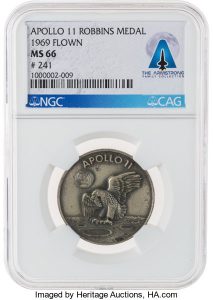
Apollo 11 Flown MS66 NGC Sterling Silver Robbins Medallion, Serial Number 241, from The Armstrong Family Collection (Courtesy of Heritage Auctions)
The practice of carrying Fliteline medals started in 1965 with the flight of Gemini 3, NASA’s first manned mission in the Gemini program. In 1968, the Robbins Company of Attleboro, Mass. was contracted to produce the Fliteline medals starting with Apollo 7.
It is reported that 480 of these 28mm medals were carried aboard Apollo 11.
According to Heritage Auctions, the most paid for a mission flown Robbins Medal was medal #241, a silver medal graded MS66 by NGC, that sold for $112,500 (including buyer’s premium) on November 1, 2018. It was sold with a Statement of Provenance signed by Armstrong’s sons as being once owned by Neil Armstrong. The provenance likely accounts for its high price.
Oct 28, 2018 | coins, history, news

An old bridge (left) and coins from the 18th century (right) were discovered in the low waters of the Danube River near Budapest (Image courtesy of euronews)
The Danube River is Europe’s second longest river. It runs from southern Donaueschingen, Germany, stretches across Europe to the Black Sea in Sulina, Romania. In ancient times, it was the border of the Roman Empire. Later, the border and the source of conflicts between the Ottoman Empire and the Kingdom of Hungary and the Austrian Habsburgs.
Today, the Danube supplies water to millions of Europeans who work together on its preservation. It is also a source for ships commercial and passenger ships traveling through Europe. Levels are so low that shipping companies have cut back on their trips and travel advisories have been issued for tourists.
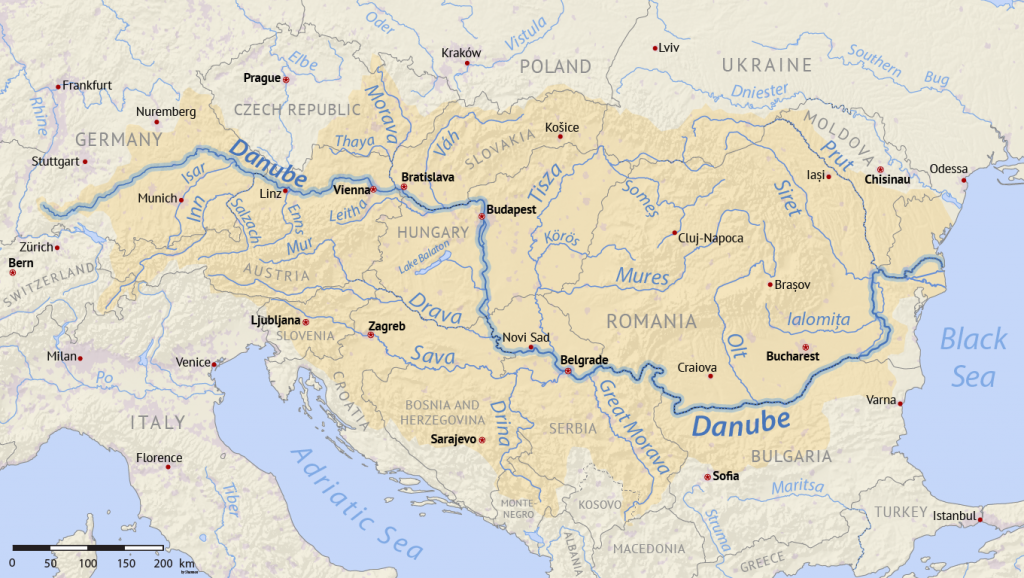
The Danube River Basin (Image courtesy of Wikipedia)
Outside of Budapest, over 2,000 silver and gold coins were found in 38 centimeters (almost 15-inches) of water. Archeologists who were called to recover the coins also found weapons, cannonballs, and other items that were said to be from a ship that sunk on the river in the 18th century.
During the 18th century, most of the area we know as Hungary today was occupied by the Ottoman Empire. Early in the 18th century, the empire instituted educational and technical reforms to strengthen their hold on their empire. In 1768, when Russian-back Ukrainian tribes entered Ottoman territory looking for confederates, the incursion provoked the Russo-Turkish War.
Over the last week, scientists have been working around the cycle of the tides to excavate the site to learn more about the ship that sank, including trying to determine why it sank. One working theory was that it was carrying supplies during the Russo-Turkish War.
Dating the wreckage using the coins may not be easy. At the time the Empire existed, coins were dated when the dies were made. Usually, dies were used until they wore out even if the coin represents the previous emperor. It could be several years before dies were made honoring the current ruler.
Beginning in the 16th century, the Ottoman mints were using screw-presses to create consistent-looking coinage. The empire of that period was always looking for the best technology to upgrade their lives and to set them apart from others. Screw presses were used for everything from minting coins to creating military medals. For the Ottoman’s, the mass production of military medals was important for the morale of the army that they put to ample use.
Although no timeline has been announced as to when scientists think they will complete their study of the artifacts, it will be an interesting view into a time at the height of the Ottoman Empire.
And now the news…

October 22, 2018
Kitco News talks with some of the most influential gold market analysts, economists, investors and mining CEOS to get their take on the industry and financial markets and the global economy  → Read more at kitco.com
→ Read more at kitco.com

October 22, 2018
Roving exhibitions have been organized in a number of primary and intermediate boys’ and girls’ schools in various regions of the Kingdom to raise awareness among students about coins and urge them to use coins in their daily dealings. The caravan started its journey this month from Riyadh.  → Read more at saudigazette.com.sa
→ Read more at saudigazette.com.sa

October 24, 2018
Nevada Day revelers can own a piece of the state’s history — and also watch it be made — as part of a special run of the coin press at he Nevada State Museum in Carson City.  → Read more at carsonnow.org
→ Read more at carsonnow.org

October 24, 2018
Two Swedish schoolchildren unearthed a 17th century coin while playing in a sandpit – and they have now been told they can keep the find.  → Read more at thelocal.se
→ Read more at thelocal.se

October 25, 2018
Aa Aa Record low water levels in the Danube have uncovered parts of an old Budapest bridge blown up by the Nazis in the final months of World War II. Pictures have emerged of the structure — which linked the districts of Buda and Pest in the Hungarian capital — just under the surface of the water.  → Read more at euronews.com
→ Read more at euronews.com

October 26, 2018
Just in time for Halloween, the Central Bank has launched a commemorative €15 Bram Stoker Dracula collector coin. The silver proof coin commemorates the life of the Dublin-born author and his famous novel Dracula, which was published in 1897 and became world-renowned after an American film adaptation starring Bela Lugosi opened in 1931.  → Read more at irishtimes.com
→ Read more at irishtimes.com

October 27, 2018
ART ON COINS — INDIA AND THE WORLD Mauryan axes, faces of Satavahana kings, a lion from Alexander’s army — at an exhibition of ancient coins found on the subcontinent , money talks. It tells stories of war, peace, power and disappointment.  → Read more at hindustantimes.com
→ Read more at hindustantimes.com

October 28, 2018
“On ANZAC Day this year I got to wear both of my medals in civilian dress and someone came up and said ”oh, you’ve got your medals on the wrong side love’, or ”whose medals are they’ — and you just have to say ”they’re mine — why wouldn’t they be?  → Read more at news.com.au
→ Read more at news.com.au
Jul 26, 2018 | coins, history, news
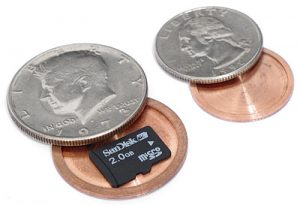
Hollow Spy Coins
(Image courtesy of ThinkGeek)
DSS is blaming an editing error with the item appearing in the report.
Although the release said the story was not true, The Associated Press quoted agency spokeswoman Martha Deutscher saying, “What’s in the report is true. This is indeed a sanitized version, which leaves a lot of questions.”
Later in March of 2009, someone had sent a link to an online merchant that was selling hollow spy coins. They were offering hollowed out quarters or half-dollars with enough room for a very small memory card. The coins are advertised to come with an unlocking ring and are “indistinguishable from regular coins when closed.”
These coins are no longer listed on that company’s website. However, if you are interested in owning your own spy coin, you can use any search engine and search for “hollow spy coins.”
I will probably not buy one. I would be afraid to carry the quarter for fear of accidentally spending it. But keeping a hollow half-dollar as a pocket piece with some “secret” information inside of it could be fun.
Original DSS Press Release
The “Defense Security Service Report Statement on Canadian Coins Incorrect, 01/12/2007” press release is no longer available on the DSS website. The following text was found on the Internet Archive Wayback Machine:
A statement in the 2006 Defense Security Service Technology Collection Trends in the U.S. Defense Industry report which claimed radio frequency transmitters were discovered embedded in Canadian coins is not true, according to DSS officials.
This statement was based on a report provided to DSS. The allegations, however, were found later to be unsubstantiated following an investigation into the matter.
According to DSS officials, the 2006 annual report should not have contained this information. The acting director of the DSS directed an internal review of the circumstances leading up to the publication of this information to prevent incidents like this from reoccurring.
The 2006 DSS Technology Collection Trends in the U.S. Defense Industry report was published by DSS in June 2006. As part of its oversight responsibilities under the National Industrial Security Program, the DSS receives reports from U.S. cleared defense industry to enhance overall security awareness in cleared industry.
Jun 6, 2018 | Canada, coins, fun, history
Hockey is to Canada as baseball and basketball is to the United States.
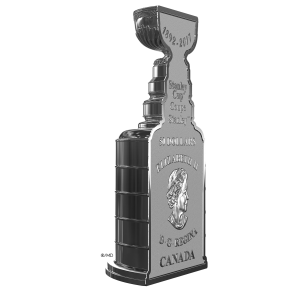
125th Anniversary of the Stanley Cup® — 3 oz. Pure Silver Coin (2017)
The early game was derived from the North American Natives game of shinney but played on the ice. From Nova Scotia, the game spread to the people living along the Saint Lawrence River in Montreal and Quebec. It quickly spread west to Ontario.
Montreal is to hockey as Springfield, Massachusetts is to basketball. The first organized games were played in Montreal where the first organized rules were formed. The first ice hockey club was the McGill University Hockey Club founded in 1877. This was followed by the Quebec Hockey Club in 1878 and the Montreal Victorias in 1881.
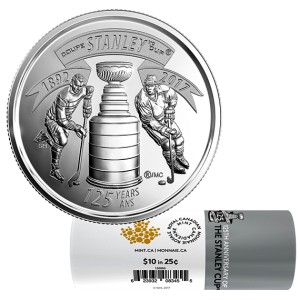
2017 25-cent 125th Anniversary of The Stanley Cup® Special Wrap Coin Roll
While ice hockey was dominating in Canada, universities in the United States had their own version of ice polo played with a ball rather than a puck. The first game between collegiate hockey clubs was played in 1893 in Baltimore when Yale beat Johns Hopkins 2-1.
Lord Stanley’s sons were so enthusiastic about hockey that they traveled the world to introduce the sport to others. By 1903 they organized a five-team European league.
The Western Pennsylvania Hockey League was formed in Pittsburgh in 1898 which primarily operated in areas within a four-hour train ride from Pittsburgh. Most of the professional players were from Canada. In 1904, a rival International Professional Hockey League was formed to include Canadian cities.
With all of the competing leagues, the National Hockey Association was formed in 1908 to organize professional hockey in the provinces of Quebec and Ontario. With western Canada feeling left out, the Pacific Coast Hockey Association (PCHA) was formed to stretch professional hockey across Canada. The two leagues negotiated a championship between them that the winner of the series would will what was then being called the Stanley Cup first awarded by Lord Stanley.
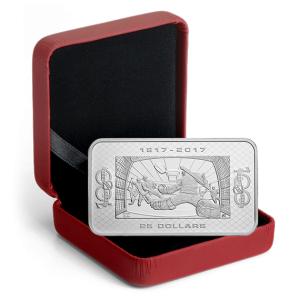
1.5 oz. Pure Silver Coin – 100th Anniversary of the NHL® (2017)
The original NHL included the Montreal Canadiens, Montreal Wanderers, Ottawa Senators, and the newly created Toronto Arenas. The Wanderers disbanded in 1918 after the Montreal Arena burned down. In 1919, the NHA’s Quebec Bulldogs joined the league bringing the number of teams back to four.
The Toronto Arenas won the first NHL championship in 1918 and then defeated the Vancouver Millionaires of the PCHA for the Stanley Cup.
The NHL expanded but found itself hurt by the Great Depression and the onset of World War II. By the 1942-43 season, the league was reduced to what has been referred to as The Original Six, the six teams that were the NHL from 1942 until the first expansion in 1967. The original six are the Boston Bruins, Chicago Black Hawks, Detroit Red Wings, Montreal Canadiens, New York Rangers and Toronto Maple Leafs.
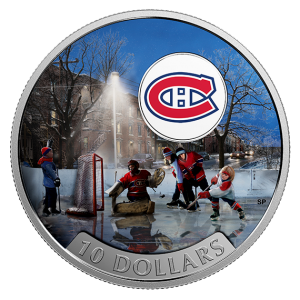
1/2 oz. Pure Silver Coloured Coin – Passion to Play: Montreal Canadiens® (2017)
Since its first presentation by Lord Stanley of Preston in 1893, the Stanley Cup has been awarded 101 times. It is the oldest team championship trophy in existence. The Montreal Canadiens have won the Stanley Cup 24 times, the most by any team. The Detroit Red Wings hold the United States record for 11 Stanley Cup victories.
Currently, the Washington Capitals are winning in the Stanley Cup Finals 3-1 against the Vegas Golden Knights. The Capitals played their first season in 1974-75 and appeared in the Stanley Cup finals once, in the 1997-1998 season. This is the Vegas Golden Knights first season as an NHL Team.
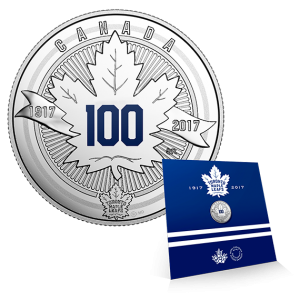
Pure Silver Coin – The Toronto Maple Leafs®: Anniversary Logo (2017)
To say that the area has gone Caps crazy would be an understatement. The neighborhood around Capital One Arena, known as Chinatown, will be flooded with fans on Thursday to watch the game outside projected on the side of the National Portrait Gallery and from the bars around the area.
In the area is the headquarters of the U.S. Mint on 9th Street NW. Although its sales counter may be open during the day, the crowds are expected to gather in the area beginning around noon. Plan accordingly.
If you are going to be in Washington and want to experience the fans Rock the Red (the Caps wear red sweaters at home leading to the moniker), you are welcome to join the crowd. If you want to avoid the crowd, find something else to do on Thursday that might be away from the area. This might be a good day to visit the Steven F. Udvar-Hazy Center of the Smithsonian’s Air and Space Museum. It is located in Chantilly, Virginia near Dulles Airport about 25 miles east of the Capital One Arena and far away from the crowd.
As for me, I will be watching from home. Since my team has not won the Stanley Cup since 1983, I am cheering for the Caps.
NOTE:
Click on any image to go to the Royal Canadian Mint’s website if you are interested in purchasing the coins shown in this post. All of the images are courtesy of the Royal Canadian Mint.
 → Read more at einnews.com
→ Read more at einnews.com
 → Read more at thecourier.co.uk
→ Read more at thecourier.co.uk
 → Read more at australianjewishnews.com
→ Read more at australianjewishnews.com

